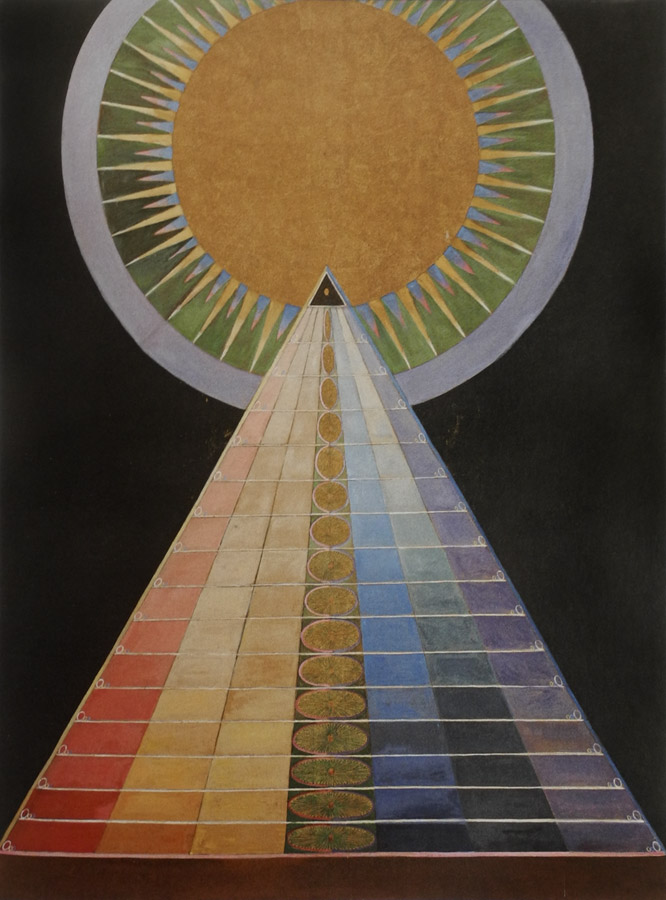One such luminary of the female art world is Hilma af Klint. The Swedish painter whose avant-garde creations continue to captivate audiences with their mystical allure and pioneering spirit. Born in 1862 in Stockholm, af Klint’s life journey traversed the realms of art, spirituality, and the esoteric. Leaving an indelible mark on the landscape of modern art.


Early Life and Influences
Hilma af Klint was raised in a family deeply entrenched in spiritual and philosophical exploration. Her father, Captain Victor af Klint, was a naval commander with an interest in mathematics and botany. While her mother, Mathilda af Klint, came from a family of priests. This familial backdrop laid the foundation for af Klint’s lifelong fascination with the intersection of science, spirituality and the unseen forces, that shape our reality.
Following: Booklet with drawings by Hilma af Klint. Source

‘Every time I succeed in finishing one of my sketches, my understanding of humanity, animals, plants, minerals, or the entire creation, becomes clearer. I feel freed and raised up above my limited consciousness.’
Hilma af Klint
Af Klint’s artistic inclinations were evident from an early age. She enrolled at the Royal Academy of Fine Arts in Stockholm, where she studied drawing and painting. However, it was her exposure to the burgeoning spiritual movements of the late 19th century that would significantly influence her artistic trajectory. Theosophy, spiritualism and the teachings of Rudolf Steiner were among the esoteric currents, that flowed through the cultural milieu of the time. Af Klint was inspired to explore the realms of the unseen and the transcendental in her art.
The Paintings of the Temple

One of the most remarkable aspects of Hilma af Klint’s oeuvre is the series of paintings known as the Paintings of the Temple. Begun in 1906, these works represent a departure from conventional artistic practices of the time. As monumental artwork, it reflects af Klint’s deep engagement with spiritualism and theosophy.


Executed in a style that blends abstract forms, geometric symbols, and vibrant colors, these paintings were, in af Klint’s own words, a visual representation of the „high spiritual messages“. A message she received through mediumistic communication with higher beings. Central to the Paintings of the Temple is af Klint’s belief in the existence of a spiritual dimension beyond the material world, populated by beings of higher consciousness.
Following: Group VI, Evolution No. 13, Hilma af Klint.

‘Only for those prepared to leave their familiar life behind, will life emerge in a new gown of continually expanding beauty and perfection. But in order to attain such a state, it is necessary to achieve stillness in both thought and feeling.’
Hilma af Klint
Through her art, she sought to convey the interconnectedness of all existence and the hidden patterns that underlie reality. The result is a series of mesmerizing canvases, that defy conventional interpretation and invite viewers to contemplate the mysteries of existence.
Reception and Legacy
Despite the groundbreaking nature of her work, Hilma af Klint remained relatively unknown during her lifetime. She belonged to a generation of female artists whose contributions were overshadowed by the dominant male figures of the art world. It was only in the latter half of the 20th century, that af Klint’s work began to receive the recognition it deserved. Scholars and curators rediscovered her visionary paintings and reassessed her place in the pantheon of modern art.


Today, Hilma af Klint’s legacy looms large in the annals of art history. Her visionary creations are serving as a testament to the power of artistic expression and the boundless depths of the human spirit. Her work continues to inspire artists, scholars and spiritual seekers alike. A broad legacy inviting us to ponder the mysteries of the cosmos and the hidden dimensions of reality. Discovering what may lie beyond the confines of the visible world.
The Echo of her Vision

In exploring the life and work of Hilma af Klint, we are reminded of the transformative potential of art. The arts are able to transcend the boundaries of the known and offer glimpses into realms beyond our comprehension.
As we gaze upon her luminous canvases, we are invited to embark on a journey of discovery and wonder: Where are the boundaries between the material and the spiritual world? Will it dissolve? May the mysteries of existence unfold in all their dazzling splendor? The enigmatic nature of her work, still fascinates and resonates deeply with the spiritual mission of female artists nowadays.


You must be logged in to post a comment.